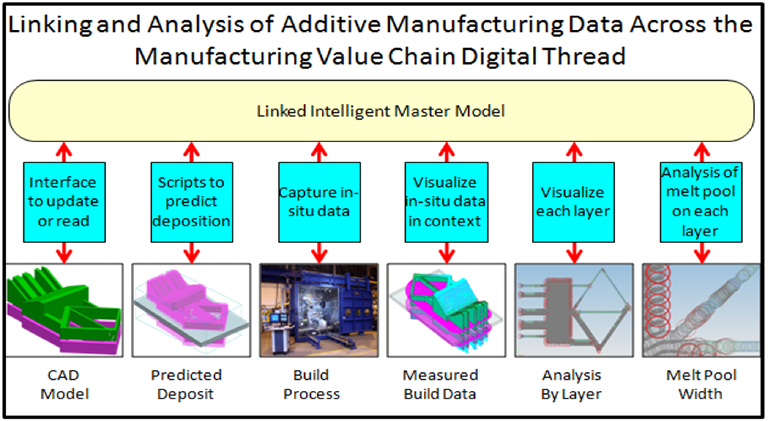


Using reliable tools focused on specific data within the AM process leads to faster production and reduced development times.
This project aims to demonstrate the use of digital thread technologies and connections to reduce the number of trial builds in small lot fabrication cycles and the post processing requirements on large lot fabrication cycles, which would result in reduced material consumption, processing times, post process finishing times, and lifecycle costs to enable faster time to market.
Problem
Piecemealed efforts by Additive Manufacturing (AM) companies has led to a confusing picture with respect to the value chain of part costs, cycle time, and product lead time.
Objective
The objective of this project is to demonstrate the use of digital thread technologies and connections to reduce the number of trial builds in small lot fabrication cycles and reduce the post-processing requirements on large lot fabrication cycles.
The net result is reduced material consumption (cost), processing time (energy and cost), post-process finishing time (energy), cycle times, lifecycle cost (material, time and energy), and enables faster time to market.
Technical Approach
The project team utilized in-situ monitoring of the build process with information mapping to both planned and post-processed non-destructive inspection (NDI) data.
Process analysis through in-situ monitoring, and NDI data were utilized to provide feedback to the pre-printing stages, for process and design improvement.
The following data was collected; modeling and design information, build planning (model translation and build parameters), in-process sensing, and post-build measurements including non-destructive evaluation and inspection methods.
This data provided the guidance required to generate alternative .stl files, automated model quality analysis, and allowed model healing and repair to ensure data provided to the build process worked the first time.
The final step was then to utilize, evaluate, and compare, planned and actual build information with NDI information, which permitted the identification of areas where process changes or design changes improved the opportunities for a successful build.
Accomplishments
The project has successfully demonstrated, through a detailed understanding and analysis of the digital thread in three AM process, with three different parts, a cost reduction of 20-44%. Much of the benefits were realized through the optimization of the design and build-prep segments. For parts with a clear AM benefit, the cost reductions are typically in the 67-75% range. The cost reductions take into consideration the saving associated with the reduction in time for design and build of a good part (iteration reduction or elimination), and the reduction in material, tools and coolant associated with non-AM processes.
The technology partners, ITI, and Stratonics, will provide the results of this project as part of standard product and service offerings, and provide the software that was developed in this program to the America Makes members via the Digital Storefront.
The end user partners (Boeing, Aerojet and Raytheon) will work with the technology partners to create a “Technology Transfer Agreement” into and onto production projects to continue to mature the developed technologies.
Dr. Jin of the UT delivered a keynote speech at the Brazilian Production Engineering Conference in October 2016 and participated in a webinar for all Institute of Industrial and Systems Engineers (IISE) members in February 2017.
Plans are underway for a similar webinar to be recorded for America Makes.
A senior design project led by five UT students related to energy assessment for AM was completed in 2016 with the support from Electric Power Research Institute.
The paper summarizing the energy assessment results of various AM process will be presented at the IISE Annual Conference in May 2017.
Project principal, Boeing, hired four UT students as interns and co-ops in 2016.
Additionally, a “Kids U” summer camp program at UT was developed for 9th – 11th graders for summer 2017. The camp program is structured to cover 3D design, 3D overview and features of AM, as well as include a tour of the Oak Ridge National Lab’s Manufacturing Demonstration Facility.
The project has successfully demonstrated, through a detailed understanding and analysis of the digital thread in three AM process, with three different parts, a cost reduction of 20-44%. Much of the benefits were realized through the optimization of the design and build-prep segments. For parts with a clear AM benefit, the cost reductions are typically in the 67-75% range. The cost reductions take into consideration the saving associated with the reduction in time for design and build of a good part (iteration reduction or elimination), and the reduction in material, tools and coolant associated with non-AM processes.
The technology partners, ITI, and Stratonics, will provide the results of this project as part of standard product and service offerings, and provide the software that was developed in this program to the America Makes members via the Digital Storefront.
The end user partners (Boeing, Aerojet and Raytheon) will work with the technology partners to create a “Technology Transfer Agreement” into and onto production projects to continue to mature the developed technologies.
Dr. Jin of the UT delivered a keynote speech at the Brazilian Production Engineering Conference in October 2016 and participated in a webinar for all Institute of Industrial and Systems Engineers (IISE) members in February 2017.
Plans are underway for a similar webinar to be recorded for America Makes.
A senior design project led by five UT students related to energy assessment for AM was completed in 2016 with the support from Electric Power Research Institute.
The paper summarizing the energy assessment results of various AM process will be presented at the IISE Annual Conference in May 2017.
Project principal, Boeing, hired four UT students as interns and co-ops in 2016.
Additionally, a “Kids U” summer camp program at UT was developed for 9th – 11th graders for summer 2017. The camp program is structured to cover 3D design, 3D overview and features of AM, as well as include a tour of the Oak Ridge National Lab’s Manufacturing Demonstration Facility.
Project Participants
Project Principal

Other Project Participants
- International TechneGroup Incorporated (ITI)
- Stratonics
- Aerojet Rocketdyne
- Raytheon
- University of Tennessee
Public Participants
- U.S. Department of Defense
- National Science Foundation
- U.S. Department of Energy
